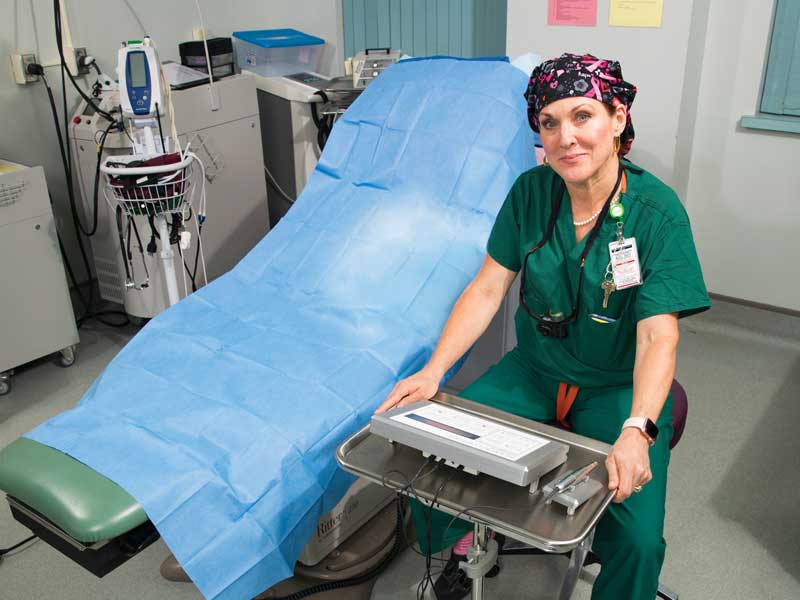Decker School of Nursing alumna helps breast cancer survivors with the help of a tattoo gun

Being compared to a Barbie doll would be a compliment for some women, but for breast reconstruction patients, it’s a painful reminder of what’s missing from their changed anatomy.
Heather Foley ’10, MS ’15, has been helping these women improve their self-esteem after learning how to do 3D areola tattooing on breast reconstruction patients. She’s the only medical professional in the Binghamton area providing this service.
Foley is a nurse practitioner at UHS Plastic & Reconstructive Surgery/Hand Surgery. She is the first nurse practitioner to work in this busy office and says that, initially, there was a bit of a learning curve.
“The surgeons didn’t know quite what to do with me at first. We had to learn together how I would fit into the office and where I could be best utilized,” she says.
Before she could assist with surgery, Foley had to complete an accredited First Assist program. Eager to gain new skills, she finished the accredited, two-year program in nine months.
“Now, I assist with a bit of everything. With breast cancer patients, I sometimes assist with both the mastectomy and the reconstructive surgery.”
For some patients, the entire nipple and areola complex must be removed. Although the patients may be cancer-free, they may feel the reconstruction isn’t complete without nipples.
“It’s hard for patients to feel whole again after their surgery. I’ve heard stories of people comparing these women to science projects, Barbie dolls or knees, just because their breasts no longer have nipples,” Foley says.
After patients heal from reconstructive surgery, they have the option to have tattoos that look like nipples added to their breasts.
Some women opt to have the nipple reconstructed using their own tissue to create a nipple and areola bump that can be tattooed for color later on, while others choose to have a nipple tattoo placed directly onto the breast mound. This is where 3D nipple tattoos, which look astonishingly real, are an ideal option.
Foley says many of her patients would never walk into a tattoo parlor, but they’re much more comfortable going to a hospital for the tattoo. Even women with religious restrictions on tattoos have found this type of tattoo to be an exception because it is deemed a medical procedure.
“One patient told me that 20 years ago, she never would have seen herself getting a tattoo, let alone two. I replied that 20 years ago, I never thought I’d be a tattoo artist — so we’re both in this together,” Foley says.
Not all patients are candidates for tattooing. Those who have undergone radiation or who have weaker immune systems can’t be tattooed.
Making the nipples look realistic can be tricky. Foley attended an accredited micropigmentation school in New Jersey to learn the 3D areola tattooing technique. She meets with a patient, does a complete medical and surgical history along with a color match, talks through the sizing the patient wants and tests the placement before ever putting ink to skin.
“It’s the only time in a woman’s life that she actually has a say in what her nipples look like. I want patients to look in the mirror every day without seeing just the scars from their surgery. I want them to be happy every day with the ‘new’ version of themselves. It is the icing on the cake,” she says.
Foley is meticulous with the process. She says that after the initial procedure, she has patients return about two weeks later for a touch-up.
“It’s mostly just to do a little extra shading here and there,” she says. “My patients are usually thrilled with the first run-through, but I’m such a perfectionist that I want to ensure the breasts and ink are symmetrical.
“I have patients who are married, and their husbands are overjoyed with the results of the tattoos. It’s something special for the husbands, too, after this long process that they’ve gone through together,” Foley adds. “It’s also very meaningful for our younger, single patients. We’ll have women in their 20s who have their whole dating life ahead of them, and they want to feel comfortable in their bodies.”
Foley says some women are more excited about their bodies than they ever were before. “One of the most modest women came out of the procedure saying, ‘I want to go to New Orleans! Look at these!’”
That level of excitement makes the whole process extremely fulfilling for Foley. It’s something unique that she’s happy to give back to women who have already gone through so much.
“I am blessed to have the ability to provide this service to our community,” she says.
